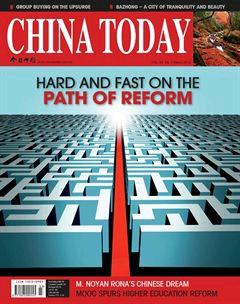Breakthroughs in Judicial Reform
By+staff+reporter+JIAO+FENG
IN 2013, China launched a series of impressive reforms in its judicial field. These included: deepening judicial publicity to guarantee peoples rights to information and develop transparency; improving the judicial accountability system to ensure the independent exercise of jurisdiction and procuratorial power, letting the inquisitor judge and the adjudicator take charge; and abolishing the system of re-education through labor as well as improving laws on punishment and correction of crimes and delinquencies, thereby manifesting the judicial assurance of human rights. By means of these reforms, Chinas judicial system has realized new breakthroughs, providing strong support for the country to build a fair, efficient and authoritative socialist judiciary.
Breakthrough in Judicial Publicity
Judicial publicity is a significant symbol of a society operating under the rule of law.
In 2013 a series of publicity campaigns paved the way for judicial reform, demystifying Chinas legal system and making justice tangible for the public.
From August 22 to 26, Jinan Intermediate Peoples Court broadcast the hearing of the Bo Xilai case via its official microblog. The court released more than 150 postings amounting to nearly 160,000 words of verbal content and a number of photos, including exhibits from both prosecution and defense teams, cross-examination details and opinions from both sides. More than 100 million people followed the trial online. It was a case that drew worldwide attention. On September 16, the official microblog of bjgy.chinacourt.org, the website of Beijings court, broadcast in real-time the key links of the case in July of a man who killed an infant girl, aged two, when he snatched her from her pram and threw her to the ground after an argument with the childs mother in Daxing District of Beijing. They included the court investigation, audio-visual material, the court debate and the final statement in 11 microblogs. In December, during the second trial of dispute between Qihoo 360 and Tencent, the Supreme Peoples Court broadcast the trial live via TV, radio and the Internet.
In addition to such trial broadcasts, a succession of measures to boost judicial publicity have been launched. On November 21, the Supreme Peoples Court opened its official microblog and WeChat account. Less than a week later, the court released opinions on building three platforms to open up the judicial process and release judgment documents and executive information. On the first day of 2014, the Provisions of the Supreme Peoples Court on the Online Issuance of Judgment Documents by Peoples Courts came into force, requiring judgment documents from more than 3,000 courts nationwide to be viewed by netizens. This has been regarded as a highlight of judicial publicity reform, embodying Chinas determination to further advance transparency in its legal system.

